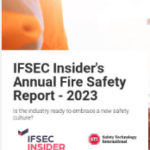 Human failings and poor management often contribute to the risk of fire. Paul Stock gives an overview of the new management system PAS 7, and how it can help to reduce that risk.
Human failings and poor management often contribute to the risk of fire. Paul Stock gives an overview of the new management system PAS 7, and how it can help to reduce that risk.
When people die in a fire there is always a time for conjecture and questions. With fire prevention it is often seen to be simply a case of dealing with the procedures associated with fire management and assessing the risks. But this emphasis on physical measures misses the point; the real risks come from human failings associated with poor management and appreciation of the human elements. In terms of fire risk, businesses and organisations concentrate too much on the physical buildings and not enough on the way they manage the people.
The physical aspects of fire management – ensuring the buildings are fire-proofed, escape routes are accessible and correct materials have been used –are all vital elements in the early stage of fire management. But managing people and ensuring they know what to do, how to do it and when to act is often neglected to the point of criminality. There is simply not enough understanding of how important this human angle is to fire prevention and risk.
The London Fire Brigade has said that the quality of fire risk management can play a greater role in managing fire risks than fire protection measures. One of the major issues in fire risk management is not the way the buildings react in the event of a fire, but the way people react and are managed. Ignorance has to be eliminated from this process and that starts from the moment a commercial premises comes into operation. This is not about telling anyone to ignore the physical element, but rather to acknowledge and work with the people who work in the buildings, manage the buildings and are directly affected by the risk of fire in them.
In order to raise standards and help save lives, a new fire risk management system specification (PAS 7) has been developed in conjunction with leading figures in the fire industry.
In simple terms it helps an organisation demonstrate how it is taking responsibility for managing fire risks and complying with the law. It also provides assurance to fire and rescue authorities in undertaking an audit under the Regulatory (Fire Safety) Order 2005. For commercial premises it will deliver a completely new level of best practice throughout any organisation.
Undertaking the process of achieving PAS 7 certification helps organisations understand the true fire risks and how best to manage them. It ensures they spend their allocated budget in a way that truly makes their people and their premises safer. No standard will reduce the errors individuals make or the unforeseeable and unexpected coincidences that can start a blaze. What such a standard will do is make people appreciate there is more to fire risk management than physical safeguards. Crisis management is often about working after an event to reduce the impact of a crisis or disaster. In terms of fire risk management, shouldn’t it be more about preventing it in the first place and taking more notice about the human element?
This standard is not only new to the fire industry sector, but it is also a new concept in this sector. We know risk starts with a person, can develop because of an individual and potentially cause the deaths of many. So it makes sense to handle the prevention in these terms. The PAS 7 standard is just one way of managing fire risks and it has to work in conjunction with engineers and designers, fire industry specialists and knowledge accumulated over a long period. But it does offer organisations a new way of showing they understand and appreciate the risks – and that they are actively managing them.
Management failings – not badly designed buildings or lack of equipment – are the main reason people die in major fires. If we accept this then any management system on offer to help reduce the risks must be embraced and not viewed with suspicion or apathy.
Paul Stock is SGS specialist auditor in fire.
Fire Safety in 2023 eBook
SHP's sister site, IFSEC Insider has released its annual Fire Safety Report for 2023, keeping you up to date with the biggest news and prosecution stories from around the industry.
Chapters include important updates such as the Fire Safety (England) Regulations 2022 and an overview of the new British Standard for the digital management of fire safety information.
Plus, explore the growing risks of lithium-ion battery fires and hear from experts in disability evacuation and social housing.



I have to say as an article this is a waste of a page. There is an opportunity here to give information about the real differences (if any) an organisation can gain from a PAS 7 accreditation. If the idea of the article is to sell PAS7 to business in my opinion it has failed.
As a consultant who works in organisations that currently have to comply with PAS standards I won’t be recommending it to any of my clients.
Rushed to look at this article thinking that there was a new PAS 7, as it is of great interest to me (fire safety) only to find that the latest is 2103, not great article, sorry!
http://shop.bsigroup.com/en/ProductDetail/?pid=000000000030252026
Sorry, typo – 2013.
Yet another certification, which actually offers no tangible benefit to the organisation, but allows consultants and auditors to make money. I agree with Chris, this article offers little in the way of useful information. If an organisation has a robust safety management system, fire will be a key element of the risk management process and dependant upon the nature of the business; should be assessed and managed accordingly. Any OH&S professional worth their salt should be taking human factors into account anyhow. Apart form the 2 main ISO’s and 18001, the other certifications don’t really add any value to the… Read more »